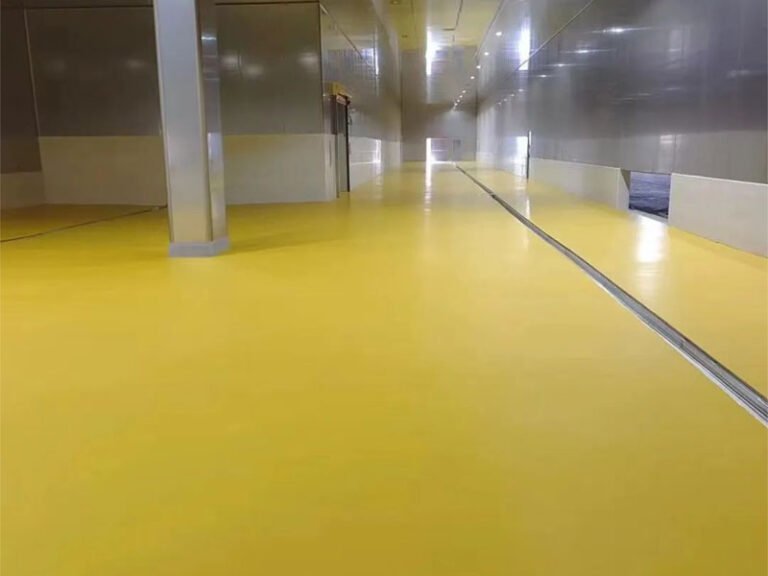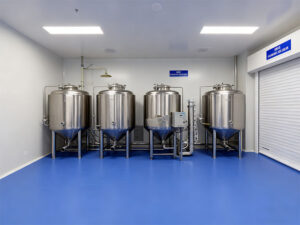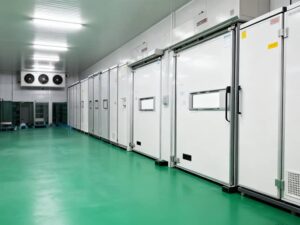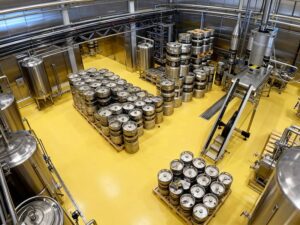Selecting the right floor coating for industrial spaces is a decision that can significantly impact the efficiency, safety, and longevity of your facility. Industrial environments, such as factories, warehouses, and workshops, demand flooring solutions that can withstand heavy machinery, high foot traffic, and exposure to chemicals or extreme temperatures.
Floor paint with polyurethane has emerged as a top choice for industrial applications due to its exceptional durability, versatility, and performance. Its ability to resist abrasion, chemicals, and UV light makes it a reliable option for businesses looking to protect their floors while maintaining a professional appearance.
The purpose of this article is to guide B2B clients—such as facility managers, project engineers, and business owners—through the key factors to consider when selecting floor paint with polyurethane for industrial use. By understanding these factors, you can make an informed decision that aligns with your facility’s specific needs and ensures long-term value.
1. Understanding Polyurethane Floor Paint
What is Polyurethane Floor Paint?
Floor paint with polyurethane is a high-performance coating specifically designed for industrial and commercial applications. It is made from polyurethane resins, which provide a durable, flexible, and long-lasting finish. This type of paint is often used in environments where floors are exposed to heavy use, chemicals, and extreme conditions.
Key Features
- Durability: Floor paint with polyurethane is highly resistant to abrasion, impact, and wear, making it ideal for high-traffic areas like factories and warehouses.
- Chemical Resistance: It can withstand exposure to oils, acids, solvents, and other industrial chemicals without deteriorating.
- Aesthetic Appeal: Available in a variety of colors and finishes (matte, satin, glossy), it enhances the appearance of industrial spaces while maintaining functionality.
- Flexibility: Unlike other coatings, floor paint with polyurethane remains flexible even after curing, reducing the risk of cracking under stress or temperature changes.
Comparison with Other Industrial Floor Coatings
- Polyurethane vs Epoxy Floor Paint: While epoxy is also durable and chemical-resistant, it is more rigid and prone to cracking under heavy loads or temperature fluctuations. Floor paint with polyurethane offers greater flexibility and UV resistance.
- Polyurethane vs Concrete Sealers: Concrete sealers protect the surface but lack the durability and aesthetic appeal of floor paint with polyurethane. Polyurethane provides a thicker, more protective layer.
- Polyurethane vs Acrylic Coatings: Acrylics are less expensive but not as durable or resistant to chemicals and abrasion as floor paint with polyurethane.
2. Assessing Your Industrial Needs
Before choosing floor paint with polyurethane, it’s essential to evaluate your facility’s specific requirements. Here are the key factors to consider:
Floor Type
Floor paint with polyurethane is compatible with various surfaces, including:
- Concrete: Ideal for industrial and commercial spaces due to its strength and durability.
- Wood: Suitable for workshops or areas where wooden floors need protection.
- Other Materials: Can also be applied to metal or previously coated surfaces with proper preparation.
Ensure the surface is clean, dry, and free of cracks or damage before application.
Traffic and Load
Consider the level of foot and vehicle traffic in your facility:
- High-Traffic Areas: Warehouses, factories, and loading docks require a coating with high abrasion resistance.
- Heavy Loads: Facilities with heavy machinery or equipment need a durable paint that can withstand impact and pressure.
Floor paint with polyurethane is designed to handle both high traffic and heavy loads, making it a reliable choice for industrial environments.
Environmental Conditions
Evaluate the conditions your floors will be exposed to:
- Chemicals: If your facility deals with oils, acids, or solvents, floor paint with polyurethane’s chemical resistance is a significant advantage.
- Moisture: Polyurethane coatings are water-resistant, making them suitable for areas prone to spills or humidity.
- Extreme Temperatures: Unlike other coatings, floor paint with polyurethane remains flexible in both hot and cold environments, reducing the risk of cracking.
Safety Requirements
Safety is a top priority in industrial spaces. Consider the following:
- Slip Resistance: Floor paint with polyurethane can be formulated with additives to create a non-slip surface, reducing the risk of accidents.
- Fire Resistance: Some polyurethane coatings are fire-retardant, meeting safety standards for specific industries.
By assessing these factors, you can determine whether floor paint with polyurethane is the right solution for your facility.
3. Durability and Performance
When selecting floor paint with polyurethane for industrial use, understanding its durability and performance is crucial. Here’s what you need to know:
How Long Does Polyurethane Floor Paint Last in High-Traffic Industrial Environments?
Floor paint with polyurethane is renowned for its long-lasting performance. In high-traffic industrial environments, such as factories and warehouses, it can last 5 to 10 years or more with proper maintenance. Its ability to withstand constant wear and tear makes it a cost-effective solution for businesses looking to minimize long-term repair and replacement costs.
Resistance to Wear, Impact, and Heavy Loads
- Abrasion Resistance: Floor paint with polyurethane is highly resistant to abrasion, making it ideal for areas with heavy foot traffic or machinery movement.
- Impact Resistance: It can withstand heavy impacts from dropped tools, equipment, or materials without cracking or chipping.
- Load-Bearing Capacity: Suitable for facilities with heavy machinery or storage racks, as it maintains its integrity under significant weight.
Performance in Extreme Conditions
Floor paint with polyurethane excels in environments with extreme temperatures and humidity:
- High Temperatures: It remains stable and flexible, even in hot environments like foundries or boiler rooms.
- Low Temperatures: Unlike other coatings, it does not become brittle in cold conditions, making it suitable for refrigerated warehouses or outdoor applications.
- Humidity and Moisture: Its water-resistant properties prevent peeling or bubbling in damp or humid areas.
4. Chemical and Stain Resistance
In industrial and commercial settings, floors are often exposed to harsh chemicals and spills. Floor paint with polyurethane is designed to handle these challenges effectively. Here’s what you need to know about its chemical and stain resistance:
Can Polyurethane Floor Paint Withstand Oils, Acids, and Other Industrial Chemicals?
Yes, floor paint with polyurethane is highly resistant to a wide range of chemicals, including:
- Oils and Grease: Commonly found in automotive workshops or manufacturing facilities.
- Acids and Solvents: Used in laboratories, chemical plants, or cleaning processes.
- Alkalis and Detergents: Often used in food processing or cleaning industries.
This resistance ensures that the coating remains intact and protective, even in environments with frequent chemical exposure.
How Does It Handle Spills and Stains in Commercial or Industrial Settings?
Floor paint with polyurethane is designed to repel spills and stains, making cleanup easier:
- Quick Cleanup: Spills can be wiped away without leaving permanent stains.
- Non-Porous Surface: Prevents liquids from seeping into the floor, reducing the risk of damage.
- Stain Resistance: Resists discoloration from common industrial substances like dyes or inks.
Comparison with Other Coatings in Terms of Chemical Resistance
- Polyurethane vs Epoxy Floor Paint: While both are chemically resistant, floor paint with polyurethane offers greater flexibility, reducing the risk of cracking under chemical exposure.
- Polyurethane vs Acrylic Coatings: Acrylics are less resistant to harsh chemicals and are more prone to degradation over time.
- Polyurethane vs Concrete Sealers: Concrete sealers provide basic protection but lack the advanced chemical resistance of floor paint with polyurethane.
5. Application and Installation
Proper application is critical to ensure the performance and longevity of floor paint with polyurethane. Here’s a step-by-step guide to help you understand the process:
Preparation
Before applying floor paint with polyurethane, the surface must be properly prepared:
- Cleaning: Remove dirt, dust, oil, and grease using industrial cleaners or degreasers.
- Repairing Cracks: Fill any cracks or holes with a suitable filler to create a smooth surface.
- Priming: Apply a primer to enhance adhesion and ensure an even finish.
Application Process
For large-scale industrial projects, follow these steps:
- Tools Needed: Use rollers, brushes, or sprayers for even coverage.
- Application Technique: Apply thin, even coats to avoid bubbles or uneven surfaces.
- Multiple Coats: Depending on the environment, 2-3 coats may be necessary for optimal protection.
Curing Time
Floor paint with polyurethane typically requires:
- Initial Drying: 4-6 hours for the surface to dry to the touch.
- Full Curing: 24-48 hours before the floor can handle heavy traffic or machinery.
- Optimal Conditions: Ensure proper ventilation and temperature (10°C to 30°C) for best results.
Professional vs DIY Application
- Professional Installation: Recommended for large or complex projects, as experts have the tools and experience to ensure a flawless finish.
- DIY Application: Suitable for smaller areas or facilities with basic requirements, provided proper preparation and application techniques are followed.
6. Maintenance and Longevity
Proper maintenance is essential to maximize the lifespan of floor paint with polyurethane and keep your industrial facility looking its best. Here’s what you need to know:
How to Clean and Maintain Polyurethane Floor Paint in Industrial Facilities
- Regular Cleaning: Sweep or vacuum daily to remove dirt and debris that can cause abrasion.
- Mopping: Use a mild detergent and warm water for routine cleaning. Avoid harsh chemicals that may damage the coating.
- Spill Cleanup: Wipe up spills immediately to prevent staining or chemical damage.
- Periodic Deep Cleaning: Use a floor scrubber or professional cleaning service for thorough cleaning every few months.
Frequency of Recoating or Touch-Ups in High-Traffic Areas
- Recoating: In high-traffic areas, floor paint with polyurethane may need recoating every 3-5 years to maintain its protective properties.
- Touch-Ups: Inspect the floor regularly and address minor scratches or wear spots promptly to prevent further damage.
Tips to Extend the Lifespan of the Coating
- Use Protective Mats: Place mats in high-traffic zones or areas prone to spills to reduce wear.
- Avoid Heavy Impact: Use padded feet on heavy equipment to minimize impact damage.
- Control Temperature and Humidity: Maintain stable environmental conditions to prevent cracking or peeling.
- Follow Manufacturer Guidelines: Use recommended cleaning products and techniques to avoid damaging the coating.
7. Cost and Return on Investment (ROI)
When choosing floor paint with polyurethane for industrial or commercial use, understanding its cost and long-term value is essential. Here’s a breakdown of the financial considerations:
Initial Cost of Polyurethane Floor Paint Compared to Other Industrial Coatings
- Polyurethane Floor Paint: While the initial cost is higher than some alternatives, it offers superior durability and performance.
- Epoxy Floor Paint: Slightly lower initial cost but may require more frequent maintenance and recoating.
- Acrylic Coatings: Least expensive upfront but less durable and more prone to wear and tear.
- Concrete Sealers: Low cost but provides minimal protection and aesthetic appeal.
Long-Term Savings Due to Durability and Low Maintenance
Floor paint with polyurethane is a cost-effective choice in the long run because:
- Durability: Its resistance to abrasion, chemicals, and impact reduces the need for frequent repairs or replacements.
- Low Maintenance: Easy to clean and maintain, saving time and resources on upkeep.
- Extended Lifespan: Lasts 5 to 10 years or more in high-traffic environments, minimizing long-term expenses.
ROI Analysis for Industrial and Commercial Projects
- Reduced Downtime: Its quick curing time allows facilities to resume operations faster, minimizing productivity losses.
- Enhanced Safety: Slip-resistant options reduce the risk of accidents, potentially lowering insurance costs.
- Improved Aesthetics: A professional appearance can enhance the value of your facility and attract clients or tenants.
- Energy Efficiency: Some polyurethane coatings reflect light, reducing the need for additional lighting and lowering energy costs.
8. Safety and Compliance
Safety and regulatory compliance are critical factors when choosing floor paint with polyurethane for industrial or commercial use. Here’s what you need to know:
Does Polyurethane Floor Paint Meet Industrial Safety Standards?
Yes, floor paint with polyurethane is designed to meet stringent safety standards, including:
- Slip Resistance: Additives can be incorporated to create a non-slip surface, reducing the risk of accidents in high-traffic areas.
- Fire Resistance: Certain formulations are fire-retardant, making them suitable for facilities with strict fire safety requirements.
- Load-Bearing Safety: Its durability ensures it can withstand heavy loads without cracking or failing, maintaining a safe environment.
Does It Meet Regulatory Requirements for Specific Industries?
Floor paint with polyurethane is compliant with regulations in various industries, such as:
- Food Processing: NSF-certified options are available for facilities that require food-safe coatings.
- Pharmaceuticals: Meets GMP (Good Manufacturing Practice) standards for cleanroom and laboratory environments.
- Manufacturing and Warehousing: Complies with OSHA (Occupational Safety and Health Administration) standards for workplace safety.
VOC Emissions and Environmental Considerations
Modern floor paint with polyurethane formulations are designed with environmental sustainability in mind:
- Low VOC Emissions: Many products are low in volatile organic compounds (VOCs), reducing harmful emissions and improving air quality.
- Eco-Friendly Options: Water-based polyurethane coatings are available, offering a more environmentally friendly alternative to solvent-based products.
- Recyclability: Some coatings can be recycled or disposed of safely, minimizing environmental impact.
9. Customization and Aesthetics
While functionality is critical in industrial spaces, aesthetics also play a significant role in creating a professional and motivating work environment. Floor paint with polyurethane offers a range of customization options to meet both practical and visual needs.
Can Polyurethane Floor Paint Be Customized for Branding or Color Coding?
Yes, floor paint with polyurethane can be tailored to suit your facility’s branding or operational requirements:
- Branding: Incorporate company colors or logos into the floor design to reinforce brand identity.
- Color Coding: Use different colors to designate specific areas (e.g., walkways, hazardous zones, storage areas) for improved safety and organization.
Available Finishes and Their Suitability for Industrial Use
Floor paint with polyurethane comes in various finishes to match your facility’s needs:
- Matte Finish: Provides a non-reflective surface, ideal for reducing glare in brightly lit areas.
- Satin Finish: Offers a balance between matte and glossy, suitable for most industrial environments.
- Glossy Finish: Enhances light reflection, brightening up spaces and making them appear larger.
How Aesthetics Enhance the Overall Look and Functionality of Your Facility
- Professional Appearance: A well-maintained, aesthetically pleasing floor creates a positive impression on clients and visitors.
- Improved Morale: A clean and visually appealing workspace can boost employee morale and productivity.
- Enhanced Safety: Color-coded floors improve navigation and reduce the risk of accidents.
- Light Optimization: Reflective finishes can reduce the need for additional lighting, lowering energy costs.
10. Case Studies and Success Stories
Real-world examples and testimonials can provide valuable insights into the effectiveness of floor paint with polyurethane in industrial and commercial settings. Here are some success stories and lessons learned:
Successful Applications of Polyurethane Floor Paint in Industrial Environments
- Automotive Manufacturing Plant: A leading automotive plant switched to floor paint with polyurethane to protect its floors from oil spills and heavy machinery. The result was a 30% reduction in maintenance costs and improved workplace safety.
- Food Processing Facility: A food processing facility used NSF-certified floor paint with polyurethane to meet hygiene standards. The coating’s chemical resistance and easy cleaning properties ensured compliance with regulations.
- Warehouse and Distribution Center: A large warehouse applied floor paint with polyurethane to its concrete floors, resulting in enhanced durability and reduced wear from forklift traffic.
Client Testimonials from Factories, Warehouses, and Commercial Spaces
- “Polyurethane floor paint has transformed our factory floors. They look professional and can withstand heavy use without damage.” – Factory Manager
- “The slip-resistant coating has significantly reduced accidents in our warehouse.” – Safety Officer
- “We love the custom color options—it’s helped us organize our workspace more effectively.” – Facility Owner
Lessons Learned and Best Practices for Future Projects
- Proper Surface Preparation: Ensure floors are clean, dry, and repaired before application for optimal results.
- Professional Installation: For large or complex projects, hiring experts ensures a flawless finish.
- Regular Maintenance: Routine cleaning and inspections extend the lifespan of the coating.
- Customization: Use color coding and branding to enhance functionality and aesthetics.
Choosing floor paint with polyurethane for industrial use is a decision that can significantly impact the efficiency, safety, and appearance of your facility. By considering factors such as durability, chemical resistance, cost, and customization, you can select a solution that meets your specific needs.
It’s essential to assess your facility’s requirements and consult with experts to ensure the best results. Floor paint with polyurethane offers a durable, cost-effective, and versatile option for protecting and enhancing industrial and commercial spaces.







